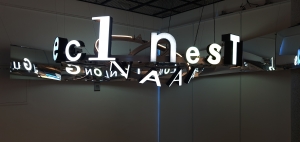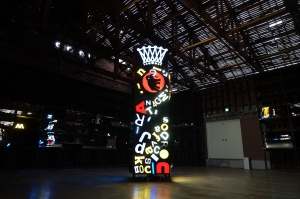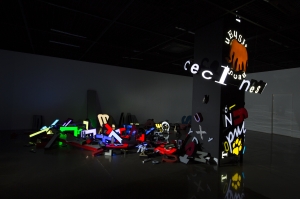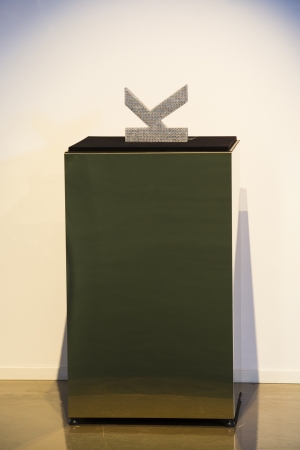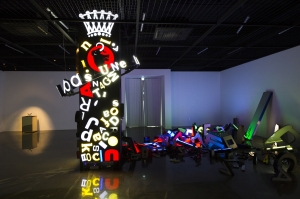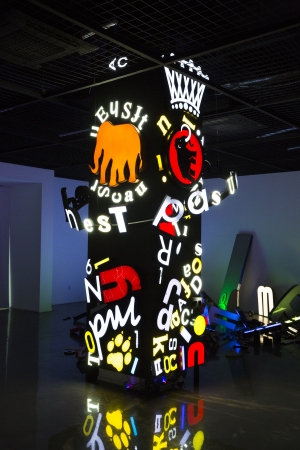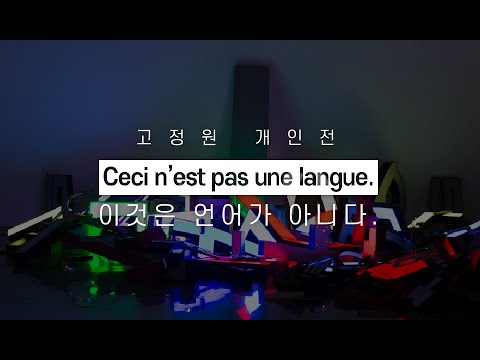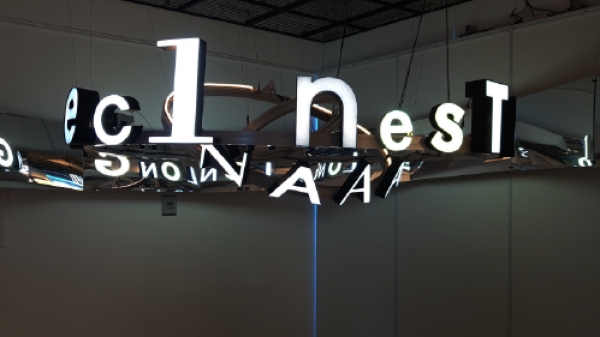전시 EXHIBITION
Ceci n'est pas une langue. 이것은 언어가 아니다.
< Ceci n'est pas une langue. > 라는 이름으로 선보이는 이번 개인전은 2019년에 발표한 작업의 제목으로 이번 전시의 주 된 내용을 담고 있다.
이번 전시에서 작가는 본인이 제작한 작업을 손수 해체하고 그것들을 다른 방식으로 소비하는 순환의 구조를 보여줌으로서 하나의 사물이 가지고 있는 역할이 다양할 수 있음을 말해주고자 했다. 또한 그 가치가 주변의 상황이나 바라보는 시각에 따라 얼마나 달라질 수 있는지를 보여주고자 했다.
-작업노트 중-
나의 작업은 내가 살아가는 현대사회에서 소비의 과속화로 인해 무분별하게 ‘버려지는 것들에 대한 연민’으로부터 시작된다. 많은 이들에게 ‘쓸모없음’으로 판단된 사물의‘쓸모’에 대한 인식을 변화시키고자 하는 나의 작업은 지나치게 당연하다고 생각되었던 많은 것들에 대해 다시 한 번 질문을 던진다.
<탑 Tower>은 쓰임이 다해 버려진 LED간판을 다시 광고탑의 형식으로 제작하고, 그것이 외부 소리로부터 반응하도록 구성된다. 광고탑의 형식을 취하고 있지만 간판이 가진 정보전달 기능을 제거함으로써 기존에 쓰였던 방식과는 다른 소비 구조를 보여준다.
-
물질의 우주 : 순환과 재생의 시
김상호 (이응노미술관 학예연구팀장)
고정원 작가는 폐기장에 버려진 간판 혹은 전통시장의 노포에 걸린 오래된 간판을 수집해 미술작품으로 재탄생시킨다. 간판을 주워오기도 하고 흥정을 통해 사기도 한다. 어떤 간판은 낡아서 벗겨져 있고 어떤 간판은 불이 들어올 정도로 말끔하기도 하다. 도시는 물론 시골동네를 돌아다니며 레트로/빈티지 스타일의 간판을 스케치하거나 사진에 담기도 한다. 가게에 붙어있던 간판이 본래적 기능과 장소를 상실한 후 전시장의 미술품으로 변환되는 과정 속에서 새로운 의미가 덧붙여지는데 작가의 이런 작업 속에서 몇 가지 흥미로운 미학적 요소를 찾아볼 수 있다.
순환
고정원 작가는 용도폐기된 간판을 다시 현실 속으로 끌어들여와 과거의 죽은 물건에 현재의 감성과 의미를 부여한다. 간판은 오래 전에 버려졌거나 기능을 상실했었지만 전시장에 되살아나 예전과는 다른 이야기를 들려준다. 그 간판은 누가 만들었는지, 어떻게 사용되었는지 혹은 (많은 경우) 어디에서 유래되었는지 알지 못한다. 마치 벼룩시장을 통해 버려진 물건들이 순환하듯이 간판은 작가를 매개로 삼아 과거와 현재를 오가고 다시 미래로 넘겨진다. 이 흐름은 시간의 순환이기도 하고, 기억의 순환이기도 하고, 말 그대로 물질의 순환이기도 하다. 그런 의미에서 고정원의 작업은 하나의 우주적 순환을 예시한다.
코스몰로지(cosmology)는 우주의 거시적 구조에 대해 논하는 천문학 영역이지만 미술 분야에서는 우주에 대한 우리의 인식 정도로 이해될 수 있을 것 같다. 고대 신화, 원시종교는 4계절의 순환, 날씨와 천재지변, 인간의 운명을 관장하는 우주에 대한 인간의 지식과 심성을 직접적으로 반영하며 만물의 유전을 하늘의 섭리, 신의 뜻으로 이해했다. 현대미술에서 우주론은 미술창작의 다양성만큼 그 경향과 양상이 다채롭지만 2000년대 들어서 ‘쓸모없는 물건’(obsolete), ‘아카이브’(archive) 개념이 자주 언급되며 우주의 순환, 시간의 흐름이라는 소재로 주목받았고 이것은 다시 우연, 불확실성이라는 테마와 섞여 우리를 둘러싼 과거, 현재, 미래를 시각예술을 통해 드러내려는 작업이 다양하게 나타났다.
이런 경향은 비단 동시대미술 뿐만 아니라 20세기의 여러 미술운동에서도 찾아볼 수 있는데 가장 대표적 예는 초현실주의의 ‘발견된 사물(found object)’에서 찾아볼 수 있다. 초현실주의 운동의 리더 앙드레 브르통이 파리의 벼룩시장에서 강한 이끌림에 이끌려 발견한 사물을 자신의 내면과 외부 현실을 잇는 오브제로 보았듯이, 고정원의 간판은 자신의 내면(매혹, 향수, 환상 등)과 외부 세계를 이어주는 연결고리가 된다. 간판은 바로 이 심리적 연결 통로와 같은 것으로 관람객은 간판이 보여주는 시간여행 속에서 작가가 느꼈던 환상과 매혹을 마주하게 된다. 동시에 우연히 눈에 띈 사물이 미술작품이 되면서 작가는 창조자인 동시에 수집가 혹은 매개자로서 자리매김 된다. 매개자라는 것은 자신의 창작 행위를 최소화하고 최대한 작품을, 레디메이드처럼, 있는 그대로 드러내는 태도이다. 고정원의 작품에서 매개의 역할이 중요한 것은 작가는 간판을 현재와 매개하면서 물질 순환 흐름의 일부가 되기 때문이다. 즉 간판을 매개하며 그 순환의 흐름 속으로 들어가게 된다. 작가는 능동적인 창조자라기 보다도 자신을 둘러싼 사물의 흐름을 드러내는데에 집중하게 된다. 고정원의 작품이 의미심장 한 것은 단순히 간판의 외면을 보기좋게 바꾸어놓는 작업이 아니라 간판을 둘러싼 커다란 흐름을 암시하기 때문이다. 그것은 마치 죽은 것을 현실과 매개하는 영매와 같다. 전시장 어두운 한 구석에 불을 깜빡이며 살아난 간판들은 마치 좀비처럼 실재로 소환된 생명체처럼 느껴지기도 한다.
아카이브
그의 간판이 가진 또 하나의 의미는 미래로의 열림이다. 자크 데리다는 그의 저서 『아카이브 열병』에서 아카이브는 존재하지 않는 과거의 흔적을 가리키는 것일 뿐 결코 과거 자체가 될 수 없다고 말한다. 오히려 아카이브는 과거의 흔적으로부터 촉발된 그것으로부터 생겨나는 미래의 이야기가 더 중요하다. 이렇게 본다면 고정원의 간판을 비롯해 용도폐기된 철지난 유행의 물건들은 단순히 과거를 지칭하는 노스탈지어적 물건이 아니라, 그것이 현재라는 시간 속에서 관람객과 정서적 화학반응을 일으키며 생성되는 미래에 대해 이야기한다고 볼 수 있다. 간판은 단순히 시간적 과거를 지칭하는 것이 아니라 끊임없이 미래의 새로운 의미를 만들어낸다는 점에서 그 미학적 가치를 찾아볼 수 있다. 간판은 과거와 현재를 오가며 동시에 미래의 예측할 수 없는 의미 역시 예비하게 된다.
우연
이 물질의 흐름 속에 개입되는 요소 중 가장 눈에 띄는 것은 우연(불확실성)이다. 어떤 간판이 어디에서 작가의 손에 걸려들지, 누가 언제 어떻게 제작한 간판인지 많은 것이 불확실하다. 특히 낱개로 버려지는 LED 글자는 더욱 그렇다. 원래의 모습을 추측할 수 없다. 그리고 이 모든 폐기물 수집 프로세스가 우발적이다. 따라서 고정원의 간판 작업은 계획된 것이 아니라 불예측적인 상황 속에서 일구어지는 순간의 예술이다. 전시장에 전시된 간판의 외형 자체만을 작품으로 볼 것이 아니라 작가의 수집 과정 자체를 작품의 일부로 봐야 한다. 그것은 작가를 둘러싼 주변과 관계를 맺는 과정이다. 마치 추상표현주의의 액션이, 해프닝의 과정이 작품의 일부가 되었듯이 고정원 작가의 수집 행위 자체도 작품의 기원을 드러내기에 예술작품의 일부로 포함시킬 수 있다. 작가의 간판 수집은 반복적이고 강박적인 행위로서 프로이드식으로 말하자면 버려지고 억눌린 욕망이 현실로 터져나올 때 발생하는 심리적 감흥 혹은 충격을 시각적으로 보여준다고 볼 수 있다. 그 심리적 양상은 보는 이에 따라 다양하게 나타날 수 있다. 어떤 이는 레트로 스타일의 간판에서 향수를 느낄 것이고, 어떤 이는 LED 불빛 속에서 강한 인상을 받을 수도 있을 것이다. 그것 또한 우연이고 불예측적인 것이다.
장소
작가의 간판은 오래된 점포의 가게에서 혹은 쓰레기장에서 떼어져 나와 미술관 전시실에서 새로운 의미를 획득한다. 이것은 장소에 따라 달리 해석되어질 수 있는 미술작품의 특성을 의미한다. 작가의 간판은 ‘장소 지향적인’ 혹은 ‘장소 반응적인’ 작품인가? 간판이 어디에 위치해 있느냐에 따라 의미가 달라지기 때문에 그렇다고 할 수 있다. 시장에 걸린 간판은 가게 상호 역할을 하지만 전시장에 걸린 간판은 다른 의미를 지니게 된다. 예술작품이 장소의 정치사회적 맥락에 따라 새로운 의미를 부여받듯이 고정원의 작품은 바로 그 지점을 정확하게 보여주고 있다.
고정원의 프로젝트는 간판을 통해 물질의 순환을 드러내는 자기성찰적 작품이다. 작가의 작업은 불확실성 속에서 이루어지는 수집 과정 자체를 전시장 속에 끌어들였고, 아날로그가 디지털로 대치되며 사라지는 시대에 간판이라는 물건도 시간의 흐름 속 어느 우연한 순간에 필연적으로 소멸할 것을, 낡고 망가져 사라질 것이라는 점까지 성찰한다. 또는 다른 장소에서 새로운 의미를 획득하며 부활해 다른 용도로 사용될 수도 있음을 보여준다. 오랜 시간이 흐른 후 작가의 이 간판들은 어디에 놓여 있을까? 어디에서 찾아볼 수 있을까? 아마도 버려질 수도 아니면 또 어떤 수집가에 의해 선택되어 다른 삶을 맞이할 수도 있을 것이다. 그의 간판은 생의 순환을 드러내는 동시에 언젠가는 소멸할 물질의 운명마저도 내재화하고 있다는 점에서 자기성찰적이다. 마치 무상한 시간처럼, 빛바랜 기억처럼 그의 간판들도 태어나고 사라지는 세계의 일부가 되어 버린 것이다.
Universe of Materials: A Poem of Circulation and Recycling
Kim Sang-ho
Head of the Curatorial Team, Lee Ungno Museum
Go JungWon collects abandoned signboards in dump sites and old ones hanging in front of old shops in traditional markets, and then regenerate them into artworks. He picks up discarded ones and buys the others by bargaining. Some are worn out while others are clean and completely intact with lights coming on. He wanders not only in cities but also in rural towns to sketch or photograph retro or vintage style signboards. New meanings are added in the process to signboards that used to be hung in front of stores as they lose their original functions and places and turn into artworks in exhibition halls, where we can find new interesting aesthetic elements in this work process as carried out by the artist.
Circulation
Go brings the discarded signboards again into reality and give present emotions and meanings to the items of the past, which used to be as good as dead. The signboards were abandoned or lost their functions long time ago, but come back to life in the exhibition hall and tell us stories different from the past. We don’t know who made the signboards, how they were used or, in many cases, where they originally came from. As abandoned items are circulated through flea markets, the signboards come and go between the past and present through the artist and are sent to the future. This passage is the circulation of time, circulation of memory, and circulation of materials. In this sense, Go JungWon’s work exemplifies a cosmic circulation.
Cosmology is a field of astronomy on the macroscopic structure of the universe, but in art, it may be understood as our perception of the universe. Ancient mythologies and primitive religions directly reflected human knowledge and feelings about the circulation of four seasons, weather and natural disasters, and the universe that controls people’s destinies, and recognized the constant flow of everything as the providence of heaven and God’s will. Cosmology in modern art has a variety of different trends and aspects as much as the diversity of art creation. In the 2000s, the concepts of ‘obsolete’ and ‘archive’ were frequently mentioned, drawing attention with subjects including the circulation of the universe and the flow of time, which in turn got mixed with the themes of contingency and indeterminacy and led to the emergence of varied efforts to reveal the past, present and future surrounding us through visual arts.
This tendency can be found not only in contemporary art but numerous art movements of the 20th century, and a key example is ‘found object’ in surrealism. As Andr? Breton, the leader of the Surrealist movement, considered items he was strongly attracted to and discovered in flea markets in Paris as objects that connect his inner self and external reality, Go’s signboards serve as links that connect his inner self (fascination, nostalgia, illusion, etc.) and the outside world. Signboards are like psychological passageways, and viewers are led to face the illusion and fascination that the artist felt in the time travel presented by them. As objects that he accidentally found become artworks, the artist becomes a creator and a collector or intermediary at the same time. Being an intermediary means taking an attitude of minimizing one’s creative activities and exposing the works as they are, like ready-mades, as much as possible. The importance of the intermediary role in his works is due to the fact that the artist mediates between signboards and the present, becoming a part of the circulation flow of the materials. While mediating for the signboards, he joins the flow of circulation. Rather than being an active creator, the artist pays attention to exposing the flow of the objects that surround him. The reason why Go’s works are significant is that he does not beautify their appearances but suggests the overall flow encircling them. It is similar to the role of a psychic who mediates between the dead and reality. Signboards lit up and alive in the dark corner of the exhibition hall give a certain impression of living things that have come back to life like zombies.
Archive
Another meaning of his signboards is openness toward the future. In his book Archive Fever, Jacques Derrida wrote that an archive indicates traces of the past that does not exist, and cannot be the past itself. Rather, the stories of the future, generated from something stirred up from the traces of the past, are more important for the archive. In this regard, Go’s discarded and outdated objects including the signboards are not to be seen merely as nostalgic items referring to the past, but to talk about the future being generated in emotional chemical reactions with viewers in the present. We can recognize the aesthetic value of the signboards in terms of its continuous creation of new meanings for the future, rather than its indication of past temporality. Moving between the past and the present, the signboards also provide preparations for the unpredictable meanings of the future.
Contingency
What stands out the most among the factors involved in the flow of the materials is contingency (indeterminacy). We can’t be sure where and what kinds of signboards will be collected by the artist, and who made them, when and how. This is especially true of LED letters abandoned piece by piece, whose original appearance we can’t even guess. Also, the entire waste collection processes are quite haphazard. Thus Go’s signboard works are not produced according to plans but are the outcomes of momentary works initiated in unforeseen situations. We should not regard just the appearances of the signboards displayed in the exhibition hall as artworks, and the artist’s collection process should be seen as part of them. It is the process in which he builds relationships with his surroundings. As actions or happenings in abstract expressionism have become part of the works, Go’s actions related to collecting signboards, which reveal the origins of the works, can be included as part of them. His collection of signboards is a repetitive and obsessive behavior, which, according to Freudian theories, can be considered to show psychological inspirations or impacts generated when abandoned and suppressed desires burst out in reality. The psychological impacts may appear in various different ways to different viewers. Some people may feel nostalgic to see the retro-style signboards, and some may be strongly impressed by LED lights. These reactions are also coincidental and unpredictable.
Place
The artist’s signboards are separated from old shops or dump sites and acquire new meanings in the exhibition hall of a gallery. This signifies the characteristics of artworks that can be interpreted in different ways according to their locations. Are his signboards ‘place-based’ or ‘place-reactive’? Their meanings change according to where they are located. Signboards in the market plays the role of informing what the titles of the shops are, but those hanging in the exhibition hall takes on different meanings. Artworks are given new meanings based on the political and social contexts of the places, and this is clearly demonstrated by Go’s works.
Go JungWon’s project consists of introspective works that reveal the circulation of materials through signboards. His works introduced the process of collection carried out in indeterminacy in the exhibition hall, and provides reflection on the fact that signboards will inevitably become extinct at an accidental point in the flow of time, in an age where analog is replaced by digital and is disappearing. Or, he shows that they can obtain new meanings and come back to life in different places, thereby being used for new purposes. Where will these signboards be placed after time goes by? Where will we be able to find them? Maybe they will be abandoned, or they can be chosen by other collectors and start new lives. His signboards are introspective in the sense that they reveal the circulation of life and at the same time, have internalized the fate of materials that will go extinct someday. His signboards have become part of the world that comes into being and then disappear, just like transient time and faded memories.
- 기간
- 2019-11-21 ~ 2019-12-2
- 관련행사






